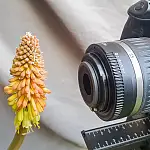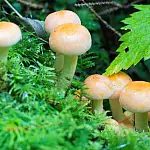How to Photograph Butterflies and MothsExquisitely beautiful, the butterfly is one of our most treasured insects. We guide you through the process to photograph butterflies.
What Are Butterflies?
Butterflies form a small part of a vast plethora of bugs frequently referred to as moths, or the lepidoptera which translates to 'scale-wing'; a reference to the myriad of tiny scales protecting the wings of most butterflies and moths. The primary distinction between butterflies and moths is how in which the wings are coupled. Moths had a frenulum, which fastens the hind wings to the fore wings so that they perform in unison in flight. With butterflies, this is accomplished with the wings overlapping so they're able to flutter with hind and fore wings together.

Butterflies tend to have slender antennae with clubbed tips, whilst moths' antennae typically tend to be stubbier and feathered or comb-like. However, some moths do have antennae and characteristics very similar to butterflies.
Finding & Attracting Butterflies
There are around 20,000 recorded species of butterflies, with the majority found in tropical areas, such as the rainforests of Latin America. The Amazon provides the richest and most prolific habitat. But even chilly places, like the United Kingdom, can muster some lovely butterflies, which can be discovered on our downs, riverbanks, moors, in wooded spaces and even in cities.

You can attract butterflies into your garden by letting a patch of wildflowers develop to inspire caterpillars. Speckled wood, meadow brown, small heath and ringlet butterflies all eat commonplace local grasses where they're left to grow tall. In short grass, butterfly conservation experts advise planting common bird's-foot trefoil to draw in the common blue butterfly or plant strands of nettles where the caterpillars of small tortoiseshells and peacocks can thrive. Plant aubretia, dandelion, bluebells, and primrose for spring feeding; buddleia, Hebe and honeysuckle all through the summer season; and ivy, lavender, marjoram and thistles for fuelling late summer and autumn butterflies. Avoid the use of insecticides!
Attracting Butterflies with Nectar
If you do not have nectar plants in your garden, then it will nonetheless be possible to bait them with other sweet, and not so sweet, things. For example, many butterflies might be attracted to sugar syrups, rotting fruit, tree sap and even stale beer. If you have got fruit trees, let fallen fruit decay on the ground - butterflies will love you for it.

Breeding Butterflies As A Hobby
Of course, it is perfectly possible to breed your own butterflies, assuming you have got some space. There are providers of eggs and pupae and you'll be able to convert a space into a large warm room or conservatory with fine nets available on the internet. However, unless you're confident that you'll be able to take care of and spot the butterflies through to maturity and beyond responsibly and humanely, then it is a hobby most definitely left to the actual butterfly fanatics.

Finding Exotic Species of Butterflies To Photograph
For those that would really like to try their hand with larger, more vibrant subjects as well as our own native species, then there are a variety of locations where tropical species can be photographed without us having to travel to say, Guatemala, Trinidad or the Amazon. Butterfly houses provide very good opportunities for photographers to practice and refine macro skills on fascinating subjects. Unfortunately, they frequently have restrictions on tripod use. Understandably, the owners do not want photographers placing their tripod legs onto plants, roots and in all probability ground resting butterflies, or getting into the way of other guests, so a lightly more guerrilla approach to photography in those places is called for.
It's unlikely that even with a high-sensitivity digital camera, a high enough ISO could be used to get the shutter speed fast enough to overcome camera shake, even though your camera or lens has stabilisation, so you are going to have to provide your light in the form of flash, and you may get away with a monopod to supply a bit of support.
One essential bit of recommendation regarding butterfly house photography is to keep in mind that when you're entering a tropical butterfly house, you're entering a tropical climate and most times of the year the outdoor temperature will probably be much cooler, so optics will mist up when you go in. 10-15 minutes of waiting should clear it.
Tips for Photographing Butterflies
The long-accepted "proper" method to photograph butterflies has been from above, with the camera axis perfectly aligned at right angles, and with the insect's wings fully open and in focus. With the depth of field being heavily limited in close-up and macro photography, this is probably the most logical approach to get as much of the butterfly as possible in focus.
Photographers will from time to time go to extreme lengths to get that wings-open look, however, I'd much rather experiment to get a slightly different point of view of these stunning creatures. I'd even forget about the small aperture rule and opt for some limited focus with just a key feature sharp, say an eye or a proboscis or a part of the wing. Also, try some extreme angles; underneath, from the side, head on and close in.
Challenge the traditional identification book or stock shot look and revel in your interpretation of these surprising creatures in your personal way. Also, do not forget to consider the various phases of the butterflies metamorphosis - a very important part of the whole story.
Butterfly Photography Working Distance and Magnification
For live butterflies, unless it is a sunny day where the butterfly is relaced, naturally warming its open wings, and static enough to approach, then you are going to need some working distance between yourself and the butterfly. It is completely conceivable to get excellent butterfly photographs with a zoom telephoto lens, assuming it has some close-up focusing ability. if the lens won't focus closely, then you can improve this by way of including an extension tube or a mixture of extension tubes until you get the magnification you want, whilst still maintaining a reasonable distance between your lens and the subject.
Note that our native species are dainty, with fritillaries and blues having a median wingspan of around 30mm, whilst tortoiseshells and commas aren't much larger, at around 44mm. It's not until you reach the migrants like the red admiral and painted lady that wingspans increase to around 55mm. Compare these tiny wingspans of our native butterflies to more exotic tropical butterflies, just like the monarchs and swallowtails, which may have wingspans that measure well over 100mm, and you'll be able to appreciate that quite a bit of magnification is needed if the local English butterfly isn't to be a somewhat insignificant blob!
For the ultimate in high quality, the specialist macro lens is the most suitable option, ideally one that can take you to 1:1 magnification, or life-size on the sensor, with a reasonable working distance. This will provide you with extra flexibility in the kind of macro topics you'll be able to take and will increase the selection of insect species you'll be able to comfortably photograph.
Macro Lighting for Photograph Butterflies
In most instances, UK daylight isn't going to give sufficient light for hand-held photography at anything less than the widest of apertures, although a folding reflector held to the side of a nectar shrub can increase natural light. Similarly, photography in a butterfly house is also most likely to be a problem when it comes to getting sufficient speed and sufficiently small aperture required to overcome the restricted depth of field at close quarters.
Unless you're going to depend on a tripod 100% of the time, then flash is the most obvious choice to succeed in higher shutter speeds with those helpful smaller apertures. On digital camera flash, at worst, will give ugly shadows, and at very best will look unrealistic, so flash to the side on a bracket if indoors, or a separate stand or tripod if space allows, is preferable. An even better choice is a specialist macro flash lighting ring, either small flash heads on a ring on each side of the lens, or a ring flash with variable output on each side of the tube. These offer versatile and more naturally flattering lighting for closeup subjects, like butterflies.
Butterfly Photography Ethics
How do the "professional" stock photographers get those perfect wings open, flat onto the camera axis pictures? Often the butterflies are captive in a studio, or worse, victim to a controversial method which is utilized by some very widely recognized names. This trick is to catch the desired butterfly, put it in the refrigerator for many hours to chill it, then return it to a natural location, where due to the chilling, it will be unable to move for some time, thus allowing plenty of time for composition. Then, once the warmth from the sunlight or artificial light hits the butterfly, the poor creature will open its wings to full stretch to soak up the warmth it's been starved of.
Is this an ethical method to get the shot? I'll leave that up to you, however, it isn't something I'd ever want to resort to.











